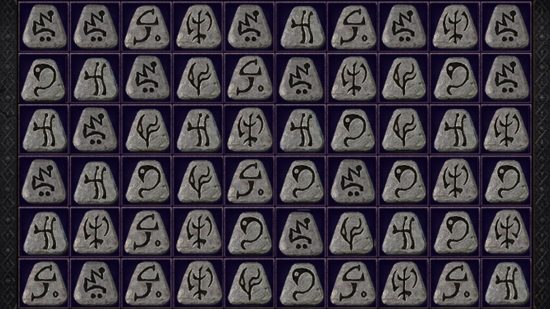What are Diablo 4 runes and runewords? The feature is one Diablo fans will recognize, the idea being that you could combine individual runes into runewords and insert them into socketed items, adding to their powers and abilities. Over a year after the ARPG game’s release, the iconic mechanic is finally back – but it’s not quite the same.
We know that D2’s beloved runeword system was not available in Diablo 4 at launch, but the Vessel of Hatred DLC finally brings the feature to D4 players. Hopefully, it will be added as free content in the future. For now, with the DLC, whichever of the five Diablo 4 classes you choose, runes can be combined and added to your items, just like D4 gems, to allow for spell casting boosts and powerful skill buffs. Here’s everything we know about Diablo 4 runewords so far.
Best Diablo 4 Runes
There are two types of Runes that you can find in the game: Ritual and Invocation-based Runes. Which ones are considered the best is a balance between the power of the invocation and how easily you can earn Offering from the rituals. There are some Legendary Runewords that have incredible power, but the amount of Offering needed makes them pointless.
For example, the Vex Legendary Rune of Invocation increases all Skills by +3 for seven seconds at a time. That’s one step below the Mythic effect of the Harlequin Crest. However, you need to accumulate 1,000 Offering to activate the Rune. Even the fantastic Bac Rune, which gives you 50 Offering every five meters traveled, won’t be enough to make it worth a slot.

The best Runes in Diablo 4 are:
- Bac (Legendary Rune of Ritual) – Travel 5 Meters to gain 50 Offering.
- Cem (Magic Rune of Ritual) – Cast Evade to gain 75 Offering.
- Tam (Legendary Rune of Ritual) – Cast a non-channeled Core Skill to gain 25 Offering.
- Lith (Legendary Rune of Ritual) – Stand still while fighting for 0.3 seconds to gain 25 Offering.
- Moni (Magic Rune of Ritual) – Cast a Skill after moving to gain 25 Offering.
- Gar (Magic Rune of Invocation) – Gain 2.5% Critical Strike Chance for 5 seconds, up to 25% for 25 Offering.
- Que (Rare Rune of Invocation) – Evoke the Druid’s Base Earthen Bulwark, granting a barrier for 300 Offering.
- Ohm (Legendary Rune of Invocation – Evoke the Barbarian’s War Cry, increasing movement speed and damage for 600 Offering.
- Wat (Rare Rune of Invocation) – Evoke the Necromancer’s Horrid Decrepify, slowing enemies and reducing their damage for 100 Offering.
- Zec (Rare Rune of Invocation) – Reduce your active Ultimate Cooldown by 2 seconds for 200 Offering.
Keep in mind that some of these Runes will work better on specific builds. An option like the Cem Rune will be fantastic for any Eagle-based Spiritborn builds but it will be horrendous for a Necromancer. As long as your build can make use of a Runeword from the list above, it’s hard to go wrong. Especially with a Bac and Ohm combination on your armor.

How do Diablo 4 runes and runewords work?
Diablo 4 runes and runewords work the same as those we’re used to in D2, in terms of combining runes and socketing them into items, but their outcome is entirely different.
These new Diablo 4 resources can now only be paired, and you must have one of each type of rune: one Rune of Ritual and one Rune of Invocation. Either rune type can be found in Magic, Rare, or Legendary rarity.
The Rune of Ritual has one type of requirement, an action, such as casting a skill with a cooldown. This first rune, when triggered, then grants the player with a certain amount of Offering.
The Rune of Invocation then is the effect of the Ritual’s cause, as it were, offering a specific buff, such as 2.5% increased Critical Strike chance for five seconds. This requires Offering, related to the amount of Offering earned from the Ritual. As such, you must consider how much Offering each grants/uses. For example, a higher value Invocation won’t work if it requires more Offering than a lower-rarity Ritual grants. However, if a Ritual grants more Offering than the attached Invocation needs, you gain a additional buff to the effect, relative to the amount of excess Offering.
So, for example, the Yul Rune of Ritual grants 50 Offering when casting a skill with a cooldown. The Gar Rune of Invocation, meanwhile, requires 25 Offering to add a 2.5% Critical Strike chance for five seconds, with a multiple stack overflow. So, pair the two together and you gain two stacks, so 5% Crit Strike chance, when you cast a skill with a cooldown.
You can only have two runewords equipped at any time, but it’s up to you which you pair together and how, so have fun with it, and figure out what works best for you – that might be a lower level Invocation rune with a powerful Offering overflow triggered by a demanding Rune of Ritual, or simply two Legendary runes.
We can’t wait for Diablo 4 runes and runewords to finally arrive with Vessel of Hatred, and we’ll update you if there’s any new information in the meantime. For now, it’s not like there isn’t plenty to keep you busy in one of the best PC games of the year, with over 120 Diablo 4 dungeons, each of which could include a surprise cameo from The Butcher, so equip the best Diablo 4 weapons and the best D4 builds – and prepare for the fight.

